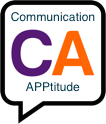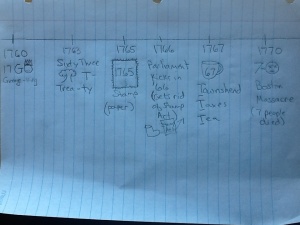Sunday, December 23, 2012
Happy Holidays
Warmly,
Deena & Beth
Tuesday, December 18, 2012
Memory Strategy for Timelines
 Beth Lawrence, MS, CCC-SLP[/caption]
Beth Lawrence, MS, CCC-SLP[/caption]Hi. I wanted to share a short post showing how important it is to anchor all information that will be needed for a test (and hopefully for long-term recall!) The images are pretty small, but if you click on them, they pop up larger.
This student was required to recall not only the events leading up to the Revolutionary War, but also the dates. He tried to simply "memorize" them, but he kept choosing the wrong dates for each event. We created a visual timeline and, because he has benefited from using rhyme in the past, we created rhymes to connect the dates and the events when we could.
In the second section, I used another strategy--ANYthing to get the information to stick! The student had to recall two facts about 1775, and we couldn't think of very much for this one, so I broke down what he had to remember into syllables, making it fit so that the first one had seven syllables (i.e., The-Bat-tle-of-Lex-ing-ton = 7) and the second had five syllables (i.e., Bat-tle-of-Con-cord = 5) for 1775. We would love to hear from you teachers, tutors and parents, about strategies you are using!
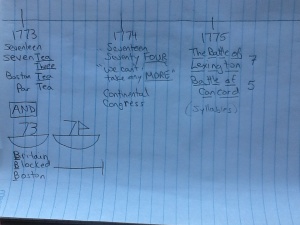
Monday, December 17, 2012
Language Games to Improve Sentences Skills
 Deena Seifert
Deena SeifertM.S., CCC-SLP[/caption]
If you are looking to add some games to your family or work collection, there are quite a few games in the stores now to improve sentence structure. Improving a student's sentence structure is not just important for conversational skills, but it's the building block of written language.
Before a child can write simple, compound and complex sentences, they must first be able to use them aloud. We do a lot of practice with our students in oral syntax (grammar). We practice making complete sentences aloud with and without pictures for cues. Just practicing this skill can be veryhum drum, so I try toincorporate a game or two into our speech-language sessions to make working on this skill more fun. Here are just a few of my favorite sentence games...

[caption id="attachment_329" align="alignleft" width="150"]
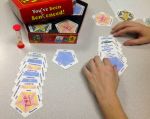 You've Been Sentenced[/caption]
You've Been Sentenced[/caption]You've Been Sentenced is a fun game of pentagonal-shaped cards. Each side of every card has a word and the points that word is worth. Players try to make the longest, most grammatically correct sentence they can and score points in the process. This has been a big hit with middle school and high school students. You can play the game as is or add on additional decks. It has add ons for players interested in pop culture, science fiction/fantasy, word challenges, sports highlights and gourmet.
[caption id="attachment_327" align="alignright" width="150"]
 Mad Libs Criss Cross[/caption]
Mad Libs Criss Cross[/caption]MadLibs Criss Cross Board Game is a fun inexpensive way to work on sentences. Cards come in 3 categories: nouns, verbs and miscellaneous. Players work on creating the longest possible sentence, each card worth points for the player. You can write in some of your own words on blank cards. Players enjoy the wacky sentences they create themselves.
[caption id="attachment_328" align="alignleft" width="150"]
 Rory's Story Cubes Actions[/caption]
Rory's Story Cubes Actions[/caption]If you are familiar with Rory's Story Cubes did you know they make an actions deck? Sometimes students get a blank look on their face when asked to create a sentence or a story. When this happens I pull out the story cubes and watch it inspire a student to create a story. The small visual pictures on the dice trigger names, objects and events to help a student create a sentence or story.
Hope this helps with your holiday shopping or inspires you to look at games in a different way. What's your favorite speech-language game or activity? Let us know!
Wednesday, December 12, 2012
Writing Checklists for Students
 Deena Seifert,
Deena Seifert,M.S., CCC-SLP[/caption]
My child is consistently getting lower marks on writing assignments, because he forgets to add a title or other detail.
Sometimes I wish I could sit on my students' shoulders in class or at home when they are writing their papers and remind them to indent, to edit their work or to remember to include a title.
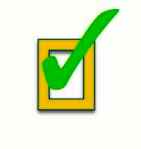 Recently, I decided to print out a checklist for one of my students whom I'll call, "Ben." I printed out multiple copies, slipped them in a polyurethane sleeve, labeled the sleeve with the class name and had the student add a set to each class binder that requires writing.
Recently, I decided to print out a checklist for one of my students whom I'll call, "Ben." I printed out multiple copies, slipped them in a polyurethane sleeve, labeled the sleeve with the class name and had the student add a set to each class binder that requires writing.I just got an email from Ben's mother saying,
Ben revised his writing assignment tonight and did such a great job. I am so proud of him. Having the checklist in his head helped as he wrote. I sat with him, asked questions, and watched him type his own thoughts. At the end he went thru the checklist again and realized he had done everything. It was such a pleasant experience. No fretting, just cheering.
Here's the checklist Ben's mother is referring to:
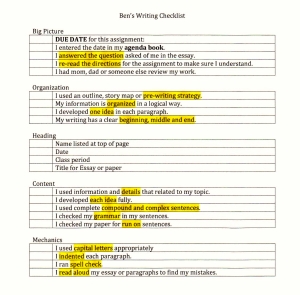
Something that was so easy to create, made a big difference in Ben and his mom's evening.
Tuesday, December 11, 2012
Working Memory Strategy
 Beth Lawrence, MS, CCC-SLP[/caption]
Beth Lawrence, MS, CCC-SLP[/caption]A couple of weeks ago, we had a post on how to help students with working memory deficits. The first step is to engage the student in dialogue about how the brain works, educating them about the processes required to perform simple short-term memory tasks versus tasks requiring active engagement while "holding onto" information. In the last year or so, I have begun using a technique that may seem a little strange, but I have seen some good results! In fact, just last week, one of my students was performing a complex language processing task that relies heavily on active listening and working memory: note-taking from an orally-presented paragraph. My student said, "OH! I just have to write down the MANCALA WORDS!" That will make no sense unless I back up and tell you the technique I had introduced to him about 4 months ago, and upon which we have been building his active listening/working memory skills.
For years I have been teaching students traditional techniques, such as visualizing, chunking and self-repetition of key words. About a year ago, one of my students simply could not grasp these concepts, and he could not identify which words in the speech stream carried more "weight" than others. I knew that I had to add a kinesthetic (i.e., hands-on experience using manipulatives) component. I did not want to write the words, because I wanted him to learn the principal of how to "highlight" words in the auditory speech stream--I did not want to give him a crutch for remembering the words, as that would not help him to improve his own memory skills. I happened to have my Mancala game with me, which contains 48 small stones and a board with 12 scoops carved into it. I wanted this student to recall directions so he could successfully complete a pencil-paper task. I placed one stone in each of the scoops on the top row of the Mancala board to represent each word in my utterance. He was to select only the stones from the top that carried strong meaning, placing them in the scoops on the lower half of the board. As he added a new stone to the bottom row, he was to chunk it and add it to the previous words. So my direction, "Write the letter A in the square," became, "Write," "Write letter," "Write letter in," "Write letter in square," as he selected each stone. He left the stones for the words, "the" in the holes on the top row. When we listen, words are not uttered and "dumped," words further down the speech stream are actively added to the previous words until one has the concept in mind.
To further enhance this experience, I teach a few basic signs for prepositions as movement helps cement location words. I have the student listen for prepositions, quickly making the sign to lock that location word in. Here is a video of a recent session with a student who held onto a two-step direction using this technique. Obviously we will need to work on increasing the speed with which she processes the language, but at this stage, she needs to rely on the kinesthetic process. [wpvideo 9Qo3ha9R][wpvideo pdCvD1Om][wpvideo RP32kmTc][wpvideo tTsiqKqV]
